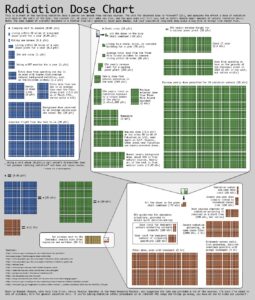Scientific measurements almost exclusively use the metric system. Each variable – mass, length, time, has a base unit in which everything is measured. They are then given prefixes to make the numbers easier to work with in calculations or conversation.
| Name | Symbol | Scientific Notation | Adjustment Factor |
| exa | E | 1018 | 1,000,000,000,000,000,000 |
| peta | P | 1015 | 1,000,000,000,000,000 |
| tera | T | 1012 | 1,000,000,000,000 |
| giga | G | 109 | 1,000,000,000 |
| mega | M | 106 | 1,000,000 |
| kilo | k | 103 | 1,000 |
| hecto | h | 102 | 100 |
| deka | da | 101 | 10 |
| 11 | 1 | ||
| deci | d | 10-1 | .1 |
| centi | c | 10-2 | .01 |
| milli | m | 10-3 | .001 |
| micro | ų | 10-6 | .000001 |
| nano | n | 10-9 | .000000001 |
| pico | p | 10-12 | .000000000001 |
| femto | f | 10-15 | .000000000000001 |
| atto | a | 10-18 | .000000000000000001 |
- Mass – The base unit of measurement is the gram. This is about the weight of a dime. If we had 1000 dimes, it would weigh 1 kg. Similarly, if we have 1 gram of mercury, we would have 1000 mg, or 1,000,000 ųg of mercury.
- There are 1,000 milligrams in one gram and about 28 grams in one (English) ounce.
- Volume – The base unit of measurement of volume is the liter. If we had one litre of water, we would have 1000 mL. Likewise, if we had 1 mL of water, we would have .001 L of water.
- Concentration – A concentration is the relationship between the amount of a substance you have, and the space you’re fitting it into. For materials dissolved in water, the concentration is usually given as mg/L, but many other systems exist.
- Milligrams/liter (mg/l) is the most common way to describe a concentration in water and is roughly equivalent to parts per million.
- Example: Health Canada guidelines for water contaminants, Maximum Allowable Concentration for mercury is 0.001 mg/L. This means that for every liter of water, there should be no more than 0.001 mg, or 0.000001 grams of mercury. In the US, the EPA standard for arsenic in drinking water is 0.01 mg/L, or 10 parts per billion (ppb).
- PPM & PPB – It’s also common to express concentration in parts-per-million (ppm) or parts-per-billion (ppb). A 1 ppm concentration of sugar in your coffee would mean that there is one sugar molecule for every million coffee “molecules.”
- One PPM is like one second in a month; one PPB is like one second in 32 years.
- One PPM is like one teaspoon of water in a 21 foot diameter, 4 foot deep swimming pool; one PPB is like one one-thousandth of that teaspoon.
- More examples:
- The lowest concentration at which most people can taste chlorine in their water is 0.156 ppm.
- Most people can just barely smell a skunk when the concentration of the animal’s scent is at 1 ppm in the air.
Radiation
It’s often said that radiation is natural, and that we are exposed to increased radiation just by flying in airplanes and sitting in the dentists chair. To put these sorts of statements into perspective, the Guardian newspaper created this table explaining effects of various levels of radiation damage, expressed in millisieverts.
| Event | Radiation reading, millisievert (mSv) |
| Single dose, fatal within weeks | 10,000 |
| Typical dosage recorded in those Chernobyl workers who died within a month | 6,000 |
| Single dose which would kill half of those exposed to it within a month | 5,000 |
| Single dose which would cause radiation sickness, including nausea, lower white blood cell count. Not fatal | 1,000 |
| Accumulated dosage estimated to cause a fatal cancer many years later in 5% of people | 1,000 |
| Max radiation levels recorded at Fukushima plant (Oct. 2015), per hour | 400 |
| Exposure of Chernobyl residents who were relocated after the blast in 1986 | 350 |
| Recommended limit for radiation workers every five years | 100 |
| Lowest annual dose at which any increase in cancer is clearly evident | 100 |
| CT scan: heart | 16 |
| CT scan: abdomen & pelvis | 15 |
| Dose in full-body CT scan | 10 |
| Airline crew flying New York to Tokyo polar route, annual exposure | 9 |
| Natural radiation we’re all exposed to, per year | 2 |
| CT scan: head | 2 |
| Spine x-ray | 1.5 |
| Radiation per hour detected at Fukushimia site, 12 March | 1.015 |
| Mammogram breast x-ray | 0.4 |
| Chest x-ray | 0.1 |
| Dental x-ray | 0.005 |
Types of radiation — It’s also important to understand the types of radiation. Alpha particles (for example, from plutonium 239) may not be energetic enough to penetrate a sheet of paper, but they are deadly if ingested. Beta particles are moderately energetic and may also cause significant tissue damage. Gamma radiation is highly energetic and also dangerous.

